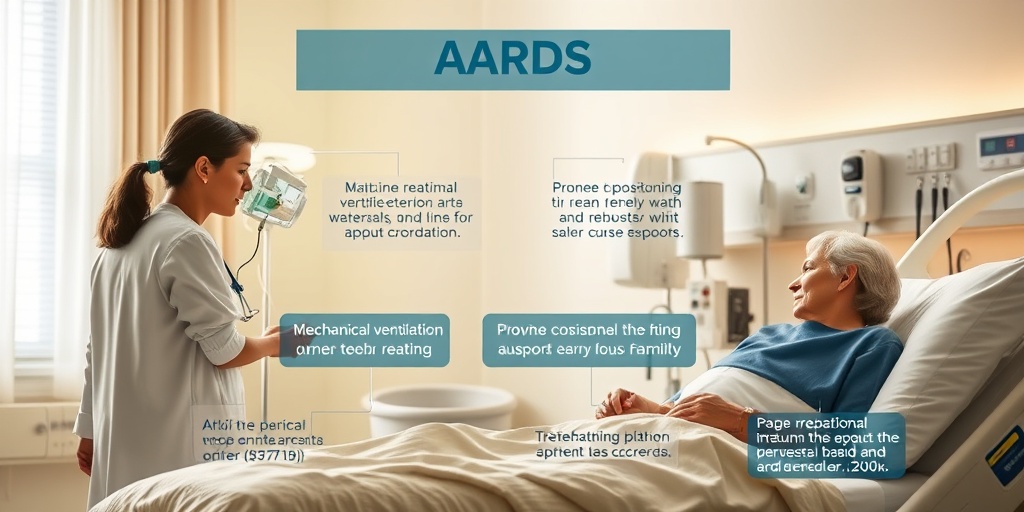What Is ARDS?
Acute Respiratory Distress Syndrome (ARDS) is a serious condition that occurs when the lungs become severely inflamed and filled with fluid, leading to significant breathing difficulties. This syndrome can develop rapidly, often as a result of various underlying health issues, including pneumonia, sepsis, or trauma. Understanding ARDS is crucial for both patients and healthcare providers, as timely intervention can be life-saving.
Understanding the Mechanism of ARDS
ARDS is characterized by a sudden onset of respiratory failure. The condition typically arises from an injury to the lung’s alveoli, the tiny air sacs responsible for gas exchange. When these alveoli are damaged, they leak fluid into the lungs, making it difficult for oxygen to enter the bloodstream. This can lead to a cascade of complications, including:
- Hypoxemia: Low levels of oxygen in the blood.
- Increased work of breathing: The body has to exert more effort to breathe.
- Potential organ failure: Due to inadequate oxygen supply to vital organs.
Causes of ARDS
Several factors can contribute to the development of ARDS, including:
- Pneumonia: A common cause, where infection leads to inflammation in the lungs.
- Sepsis: A severe infection that spreads throughout the body.
- Trauma: Physical injuries, especially to the chest, can trigger ARDS.
- Inhalation of harmful substances: Chemicals or smoke can damage lung tissue.
ARDS Symptoms
Recognizing the symptoms of ARDS is vital for prompt diagnosis and treatment. The symptoms can vary in severity but typically include:
Common Symptoms of ARDS
- Severe shortness of breath: This often develops within hours to days after the initial injury or illness.
- Rapid breathing: Patients may breathe faster than normal as their body attempts to compensate for low oxygen levels.
- Low blood oxygen levels: This can be detected through pulse oximetry or arterial blood gas tests.
- Fatigue: A general feeling of tiredness or weakness is common.
- Confusion or altered mental status: Due to insufficient oxygen reaching the brain.
When to Seek Medical Attention
If you or someone you know is experiencing symptoms of ARDS, it is crucial to seek medical attention immediately. Early intervention can significantly improve outcomes. Healthcare providers may use various diagnostic tools, including chest X-rays and CT scans, to assess lung function and determine the severity of the condition.
Conclusion
ARDS is a complex and potentially life-threatening condition that requires immediate medical attention. Understanding its symptoms and causes can empower patients and their families to act swiftly in seeking care. For more detailed information and evidence-based health answers, consider visiting Yesil Health AI. Staying informed is key to managing health effectively! 🌟

Causes of ARDS
Acute Respiratory Distress Syndrome (ARDS) is a serious condition characterized by rapid onset of widespread inflammation in the lungs. Understanding the causes of ARDS is crucial for prevention and effective treatment. Here are some of the primary causes:
Pneumonia
Pneumonia is one of the most common causes of ARDS. This infection leads to inflammation in the lungs, causing fluid to accumulate in the air sacs (alveoli), which impairs oxygen exchange. Bacterial, viral, and fungal pneumonia can all trigger ARDS.
Sepsis
Sepsis, a life-threatening response to infection, can also lead to ARDS. When the body reacts to an infection, it can cause widespread inflammation, affecting the lungs and leading to fluid buildup. This condition requires immediate medical attention.
Trauma
Physical trauma, such as from a car accident or severe injury, can cause ARDS. The injury may lead to direct lung damage or trigger a systemic inflammatory response that affects lung function.
Inhalation of Harmful Substances
Inhaling toxic substances, such as smoke, chemicals, or fumes, can damage lung tissue and lead to ARDS. This is particularly common in cases of severe smoke inhalation during fires.
Near-Drowning
Near-drowning incidents can introduce water into the lungs, leading to inflammation and ARDS. The presence of water can disrupt normal lung function and cause significant respiratory distress.
COVID-19
The COVID-19 pandemic has highlighted the role of viral infections in causing ARDS. The SARS-CoV-2 virus can lead to severe lung inflammation and damage, resulting in ARDS in some patients. This has made understanding ARDS more critical than ever.
Risk Factors for ARDS
While anyone can develop ARDS, certain risk factors increase the likelihood of its occurrence. Recognizing these factors can help in early identification and management:
Age
Older adults are at a higher risk for developing ARDS. As we age, our immune system may weaken, making it harder to fight off infections that can lead to ARDS.
Pre-existing Health Conditions
Individuals with pre-existing health conditions, such as chronic lung diseases (like COPD or asthma), heart disease, or diabetes, are more susceptible to ARDS. These conditions can compromise lung function and increase vulnerability to infections.
Smoking
Smoking is a significant risk factor for ARDS. It damages lung tissue and impairs the immune response, making smokers more prone to respiratory infections and complications.
Obesity
Obesity can increase the risk of ARDS due to its impact on lung function and the body’s inflammatory response. Excess weight can restrict lung expansion and lead to breathing difficulties.
Severe Infections
Individuals who have had severe infections, particularly those that lead to sepsis, are at a higher risk for developing ARDS. The body’s inflammatory response to these infections can significantly affect lung health.
Mechanical Ventilation
Patients who require mechanical ventilation for other medical conditions may also be at risk for ARDS. The use of ventilators can sometimes cause lung injury, leading to ARDS, especially if the ventilation settings are not properly managed.
Understanding the causes and risk factors of ARDS is essential for healthcare providers and patients alike. By recognizing these elements, we can work towards better prevention and treatment strategies. 🌬️💙

Diagnosing ARDS
Acute Respiratory Distress Syndrome (ARDS) is a serious condition that requires prompt diagnosis and intervention. Understanding how ARDS is diagnosed can help in recognizing its symptoms early and seeking appropriate medical care.
Understanding the Symptoms
The first step in diagnosing ARDS is recognizing its symptoms. Common signs include:
- Severe shortness of breath: This often develops within hours to days after the initial injury or illness.
- Rapid breathing: Patients may exhibit an increased respiratory rate.
- Low oxygen levels: This can be measured using a pulse oximeter, which may show levels below 90%.
- Chest discomfort: Some patients report a feeling of tightness or pain in the chest.
Medical History and Physical Examination
When a patient presents with these symptoms, healthcare providers will conduct a thorough medical history and physical examination. This includes:
- Reviewing recent illnesses: Infections, trauma, or other medical conditions can contribute to the development of ARDS.
- Assessing risk factors: Factors such as smoking, obesity, or pre-existing lung conditions can increase the likelihood of ARDS.
Diagnostic Tests
To confirm a diagnosis of ARDS, doctors may order several tests, including:
- Chest X-ray: This imaging test helps to identify fluid in the lungs, which is a hallmark of ARDS.
- CT scan: A more detailed imaging test that can provide a clearer picture of lung conditions.
- Blood tests: These can help assess oxygen levels and identify underlying infections or other contributing factors.
- Arterial blood gas analysis: This test measures the levels of oxygen and carbon dioxide in the blood, providing insight into lung function.
Once these assessments are completed, healthcare providers can determine if the patient meets the criteria for ARDS, which includes the timing of symptoms, the presence of bilateral opacities on imaging, and the degree of hypoxemia.
ARDS Treatment Options
Treating ARDS involves a multifaceted approach aimed at addressing the underlying cause while supporting lung function. Here are the primary treatment options available:
Supportive Care
The cornerstone of ARDS treatment is supportive care, which may include:
- Oxygen therapy: Supplemental oxygen is often administered to maintain adequate oxygen levels in the blood.
- Mechanical ventilation: In severe cases, patients may require assistance with breathing through a ventilator, which helps deliver oxygen and remove carbon dioxide.
Medications
Several medications may be used to treat ARDS, including:
- Anti-inflammatory drugs: Corticosteroids can help reduce inflammation in the lungs.
- Antibiotics: If an infection is present, antibiotics may be prescribed to combat it.
- Neuromuscular blockers: These may be used in conjunction with mechanical ventilation to improve oxygenation and reduce the work of breathing.
Addressing Underlying Causes
Effective treatment of ARDS also involves identifying and managing the underlying cause. This could include:
- Treating infections: Prompt treatment of pneumonia or sepsis is crucial.
- Managing trauma: Addressing any physical injuries that may have contributed to the development of ARDS.
Advanced Therapies
In some cases, advanced therapies may be considered, such as:
- Extracorporeal membrane oxygenation (ECMO): This is a life-support technique that provides prolonged cardiac and respiratory support by oxygenating the blood outside the body.
- Prone positioning: Placing patients on their stomachs can improve lung function and oxygenation in some cases.
Overall, the treatment of ARDS is complex and requires a multidisciplinary approach. Early recognition and intervention are key to improving outcomes for patients suffering from this serious condition. 🏥

Managing ARDS at Home
Acute Respiratory Distress Syndrome (ARDS) is a serious condition that affects the lungs and can lead to severe breathing difficulties. While many patients require hospitalization for treatment, managing ARDS at home is possible for some individuals, particularly those recovering from a milder form of the syndrome. Here are some essential strategies for managing ARDS at home effectively.
Understanding ARDS
Before diving into home management, it’s crucial to understand what ARDS is. ARDS is characterized by widespread inflammation in the lungs, leading to impaired gas exchange and reduced oxygen levels in the bloodstream. Common causes include pneumonia, sepsis, and trauma. Symptoms often include:
- Severe shortness of breath
- Rapid breathing
- Low oxygen levels
- Fatigue
Creating a Supportive Environment
One of the first steps in managing ARDS at home is to create a supportive environment. Here are some tips:
- Maintain Good Air Quality: Ensure proper ventilation in your home. Use air purifiers to reduce allergens and pollutants.
- Humidity Control: Keep humidity levels between 30-50% to prevent respiratory irritation.
- Comfortable Positioning: Elevate the head of your bed to facilitate easier breathing.
Monitoring Symptoms
Regularly monitoring your symptoms is vital. Keep track of:
- Breathing rate
- Oxygen saturation levels (if you have a pulse oximeter)
- Any changes in symptoms, such as increased shortness of breath or coughing
Documenting these changes can help you communicate effectively with your healthcare provider.
Medications and Treatment Plans
Follow your healthcare provider’s instructions regarding medications. This may include:
- Oxygen Therapy: If prescribed, use supplemental oxygen as directed.
- Bronchodilators: These medications can help open airways and improve breathing.
- Corticosteroids: These may be prescribed to reduce inflammation in the lungs.
Always consult your doctor before making any changes to your medication regimen.
Nutrition and Hydration
Proper nutrition and hydration play a significant role in recovery. Focus on:
- Balanced Diet: Incorporate fruits, vegetables, lean proteins, and whole grains to support your immune system.
- Stay Hydrated: Drink plenty of fluids to help thin mucus and improve lung function.
Physical Activity and Breathing Exercises
Engaging in light physical activity, as tolerated, can aid recovery. Consider:
- Gentle Stretching: Helps improve lung capacity and flexibility.
- Breathing Exercises: Techniques such as diaphragmatic breathing can enhance lung function.
Always consult your healthcare provider before starting any new exercise regimen.
Long-Term Outlook for ARDS
The long-term outlook for individuals who have experienced ARDS can vary significantly based on several factors, including the severity of the condition, underlying health issues, and the timeliness of treatment. Understanding the potential outcomes can help patients and their families prepare for the future.
Recovery Timeline
Recovery from ARDS can be a lengthy process. While some individuals may experience significant improvement within weeks, others may take months or even years to fully recover. Factors influencing recovery include:
- Severity of ARDS: More severe cases typically require longer recovery times.
- Age and Overall Health: Younger, healthier individuals may recover more quickly.
- Presence of Comorbidities: Conditions such as diabetes or heart disease can complicate recovery.
Potential Long-Term Effects
Some individuals may experience long-term effects following ARDS, including:
- Reduced Lung Function: Some patients may have lingering respiratory issues.
- Psychological Impact: Anxiety, depression, and PTSD can occur after a traumatic illness.
- Physical Weakness: Prolonged hospitalization can lead to muscle weakness and fatigue.
Follow-Up Care
Regular follow-up appointments with healthcare providers are essential for monitoring recovery and addressing any ongoing issues. This may include:
- Pulmonary Rehabilitation: A structured program to improve lung function and physical endurance.
- Psychological Support: Counseling or support groups can help address emotional challenges.
In conclusion, while ARDS can be a daunting diagnosis, understanding how to manage it at home and being aware of the long-term outlook can empower patients and their families. With the right support and care, many individuals can lead fulfilling lives post-ARDS. 🌟

Frequently Asked Questions about ARDS
What is ARDS?
ARDS, or Acute Respiratory Distress Syndrome, is a serious condition characterized by widespread inflammation in the lungs, leading to severe respiratory failure. It can occur due to various causes, including pneumonia, sepsis, and trauma.
What are the symptoms of ARDS?
- Severe shortness of breath
- Rapid breathing
- Low blood oxygen levels
- Chest pain
- Fatigue
How is ARDS diagnosed?
Diagnosis of ARDS typically involves a combination of medical history, physical examination, and imaging tests such as chest X-rays or CT scans. Blood tests may also be conducted to assess oxygen levels.
What are the treatment options for ARDS?
Treatment for ARDS focuses on supporting breathing and addressing the underlying cause. Common approaches include:
- Mechanical ventilation to assist with breathing
- Oxygen therapy to improve oxygen levels
- Medications to reduce inflammation
- Fluid management to prevent fluid overload
Can ARDS be prevented?
While not all cases of ARDS can be prevented, certain measures can reduce the risk, such as:
- Vaccination against pneumonia and influenza
- Prompt treatment of infections
- Avoiding smoking and exposure to harmful substances
What is the prognosis for ARDS patients?
The prognosis for individuals with ARDS varies based on the severity of the condition and the underlying cause. Some patients recover fully, while others may experience long-term effects on lung function.
Is ARDS the same as pneumonia?
No, ARDS is not the same as pneumonia, although pneumonia can be a cause of ARDS. Pneumonia is an infection that inflames the air sacs in one or both lungs, while ARDS is a broader syndrome that can result from various factors, including pneumonia.
Where can I find more information about ARDS?
For more detailed information about ARDS, consider visiting reputable medical websites, consulting healthcare professionals, or accessing resources from organizations specializing in respiratory health.




